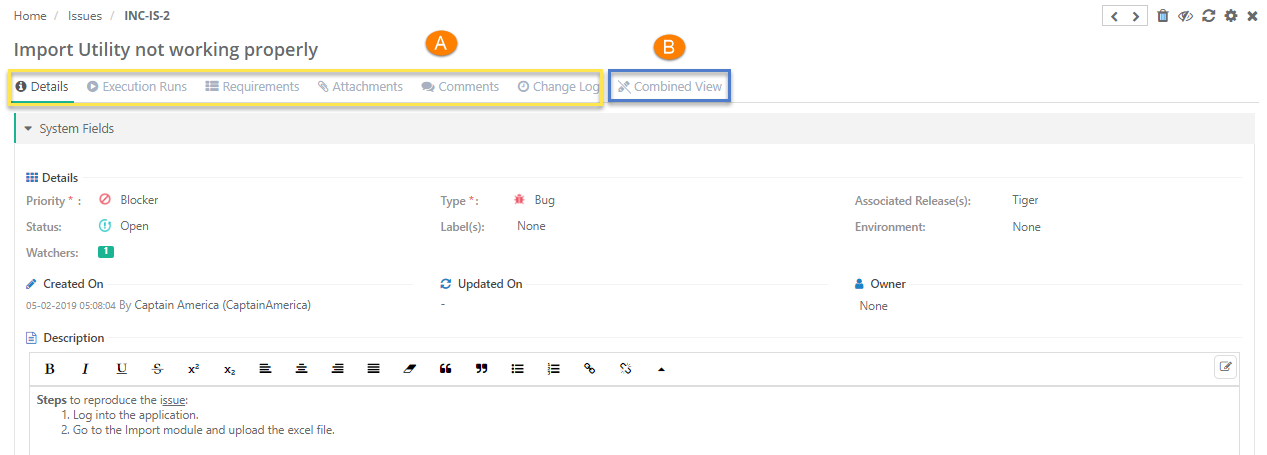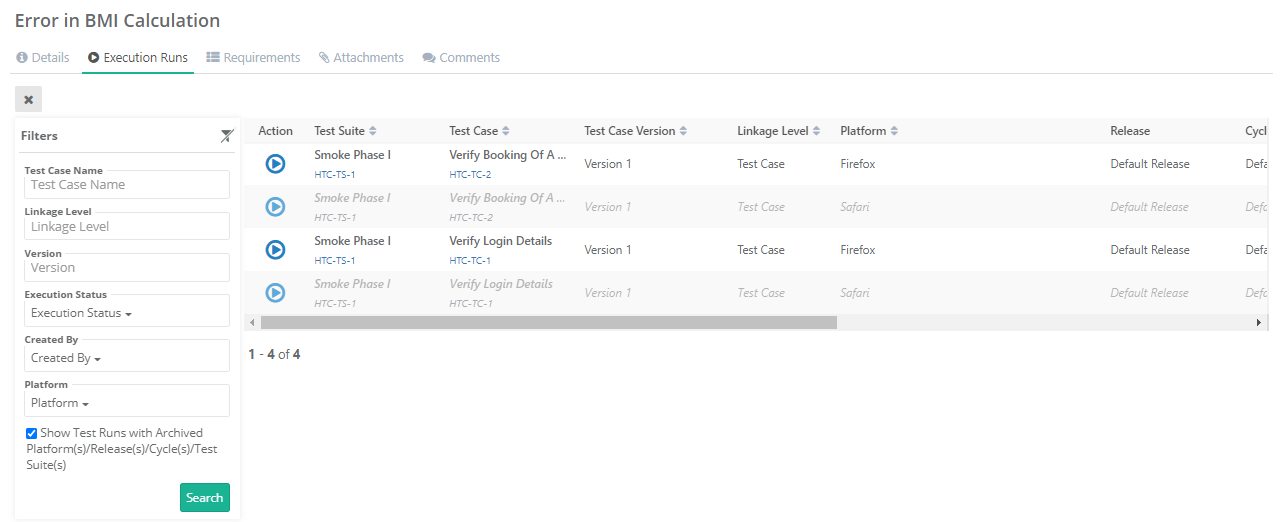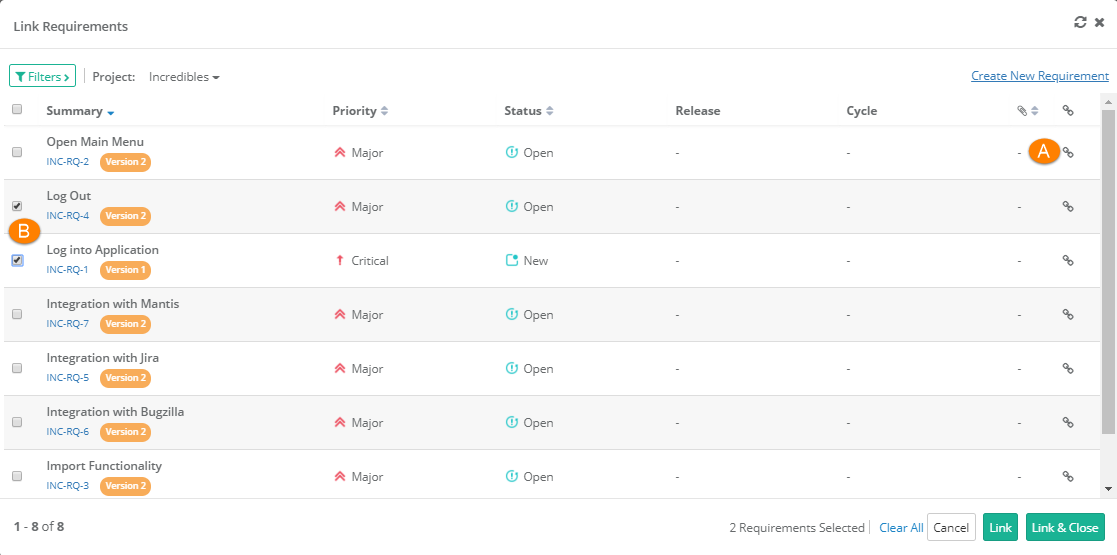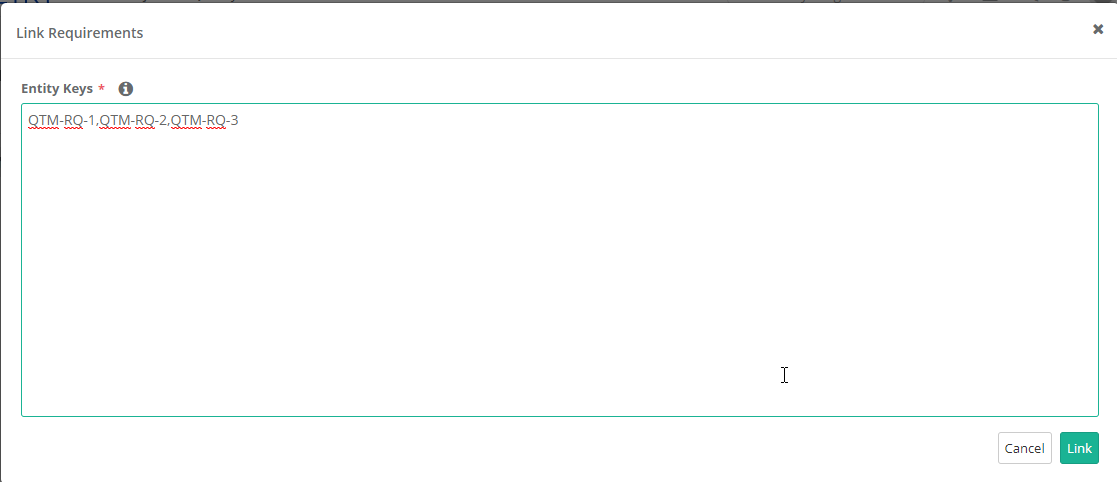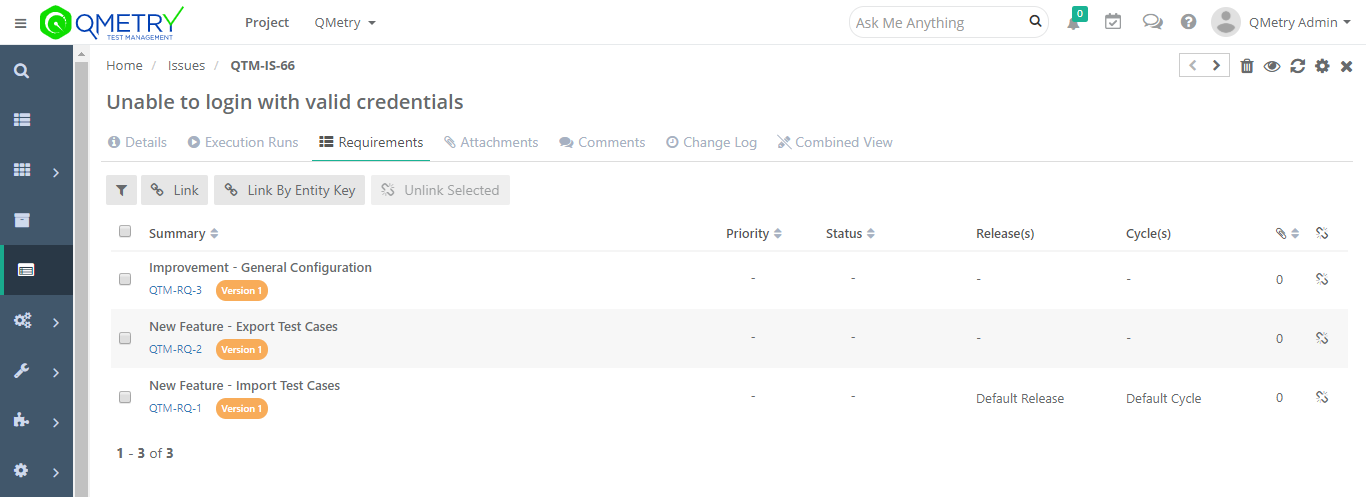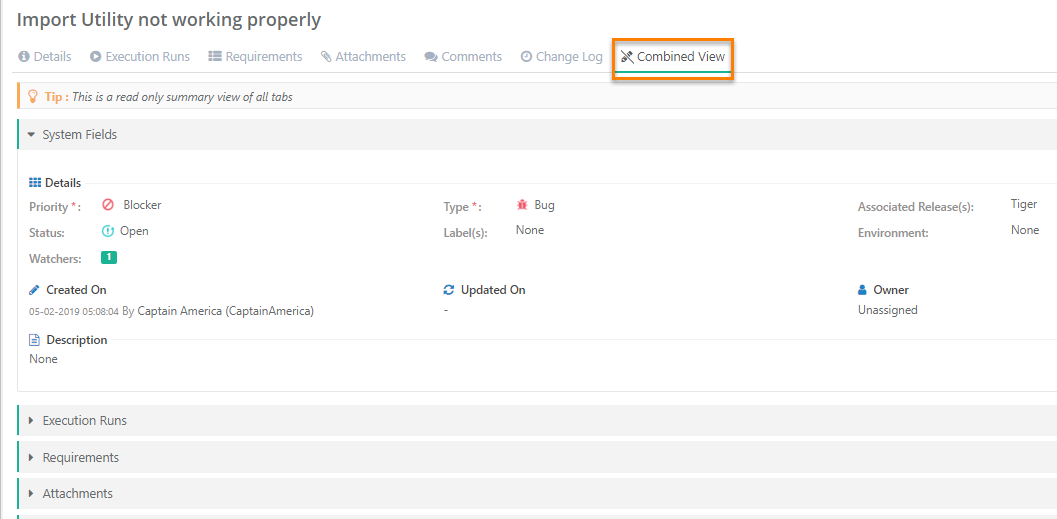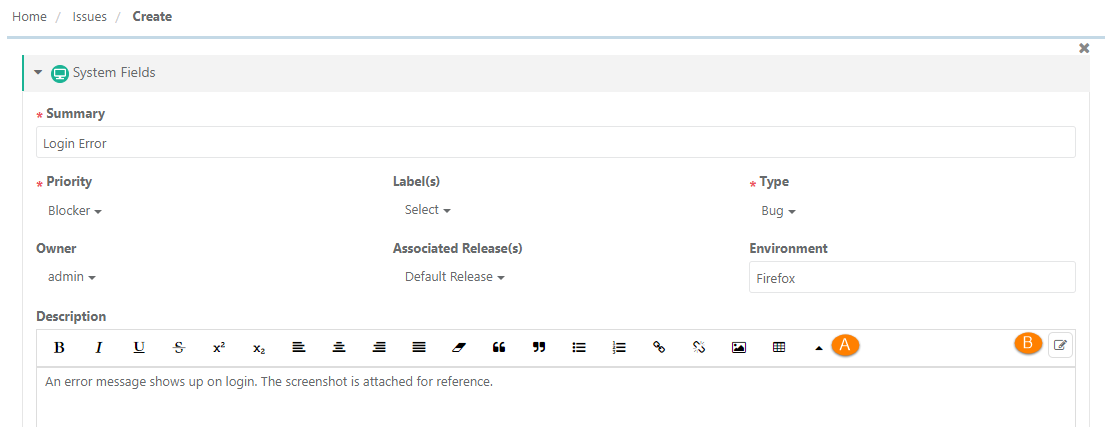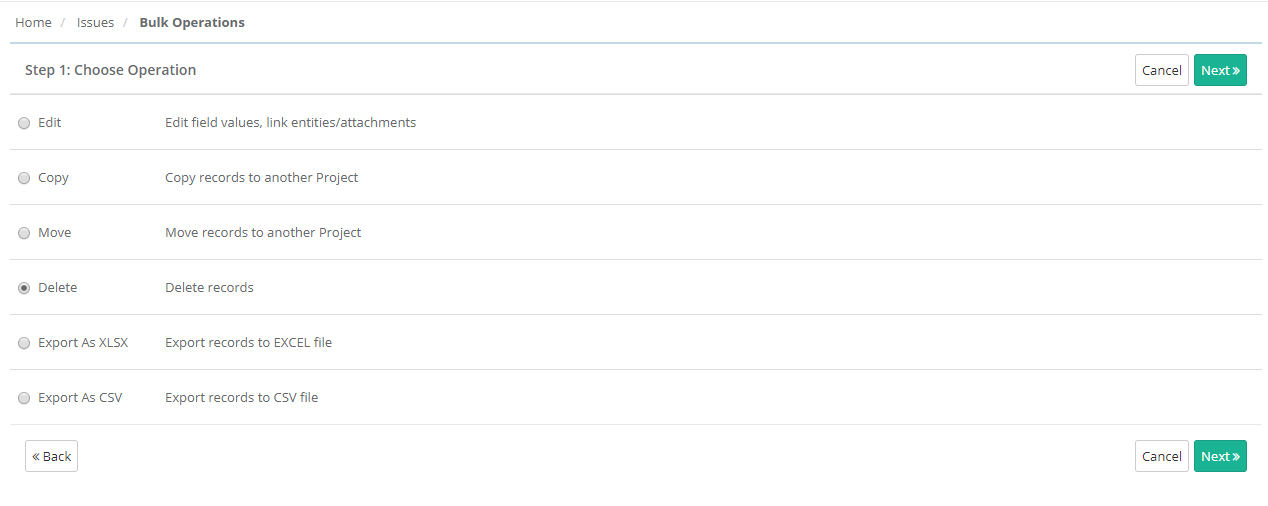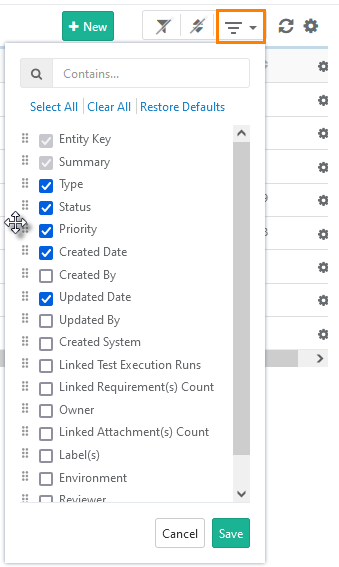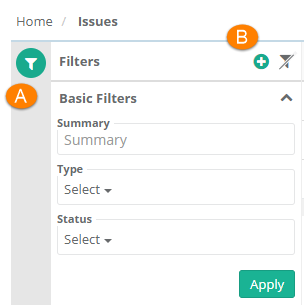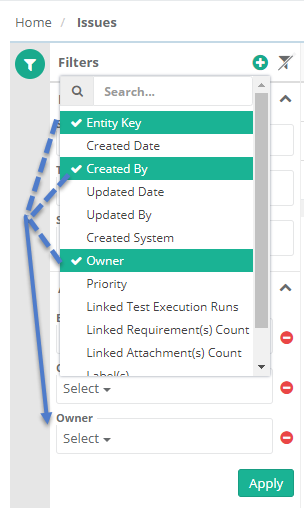Back to QMetry All Products Help Page
Projects using QMetry internal issue module for Issue (Bug) Tracking
This document is applicable only when your project is not configured with an external issue tracker like Jira. If the Jira project is integrated with your QMetry project, refer to Projects using Jira integration for Issue (Bug) Tracking.
Issue module allows you to manage issues internally in QMetry. Users can create, view, and modify issues in the QMetry without any integration with external tools to manage the issues. Users can also create custom fields to customize issue details as per business practices.
Users can perform the following tasks in the Issue module:
- View, Add, Modify, Delete issues
- Manage Issue Grid in accordance with the fields you want to display/hide on the screen
- Add new custom fields, add new values to system-defined fields as per your business practices
- Bulk Operations
- Set e-mail Notifications for multiple triggers
- Issues logged from the execution screen while execution will be available in the Issue module.
View, Add, Modify, Delete issues
View and Organize Issue Details
Just click on the Issue Key in the grid view to open the issue detail page on the same page. To open the issue detail page in new tab/window, right click on the Issue Key in grid view. Opening issues in different tab/browser makes comparison between issues easier. It also provides quick reference while working on multiple assets. The detail page has one click access to different sections using organizable tabs.
The details can be view in two ways -
A. Individual Section Tabs
B. Combined View (Read Only View)
A. Individual Section Tabs
For Issue: There are individual tabs for Details, Execution Runs, Requirements, Attachments, Comments, Change Log.
Each tab displays relevant details. The details are editable.
Details tab
The Details tab will show you the following details:
- Summary: View the summary of the Issue.
- Priority: Assign priority to the issue by selecting appropriate option from the drop-down. It is a mandatory field.
- Type: Assign a type to the issue e.g. Bug, New Feature. It is a mandatory field.
- Status: When an issue is created, it has default status Open.
- Owner: If you want to assign the issue, then use the Owner field and select the user who will be assignee of the issue.
- Release: Assign relevant release to the issue by selecting appropriate option from the drop-down.
- Labels: Add respective tags as labels to filter or differentiate the issues.
- Environment: Enter environment details in which the issue was found e.g., Chrome, Firefox, Production, Staging, etc.
- Description: Enter description for the issue. Description can be added either in Plain Text or Rich Text. Enable Rich Text and Source Code Editor: Refer to the Description field above for more details.
- User Defined Fields: If UDFs are added for the Issues module, then they are displayed on the Create Issue and Issue Details screen.
Execution Runs
Issues logged from Test Executions module are displayed here.
View Archived Test Runs
An execution/test run is archived when either Platform/Release/Cycle/Test Suite is archived. When a test suite, platform or Release/Cycle is archived, the test executions having such test suite/platform/release/cycles associated with them will be hidden on the Execution Runs tab of the test case.
The Show Test Runs with Archived Platform(s)/Release(s)/Cycle(s)/Test Suite(s) check box is provided on the Test Executions tab. To view the test runs which are archived either due to platforms/release/cycles, select the check box in the filter.
Execution Time and Remaining Time
Open the issue detail page and open the Execution Runs tab. Users can view Execution Time and Remaining Time calculated for Test Execution.
Use Case: Calculation of Execution Time and Remaining Time for test suite is useful for QA Manager in Test Planning as it gives accurate estimates for the test suite. These test case level estimates refine each time a test suite is executed. Testers can make recommendations to have the test estimates revised based on the last few executions in different environments.
Two columns Execution Time and Remaining Time are added on the grid at the following places in the application:
- Test Suite detail page > Test Executions tab
- Test Case detail page > Test Executions tab
- Issue detail page > Execution Runs
Calculation of Execution Time of a test suite:
Execution Time of a test suite is calculated based on Estimate Time of all the test cases in that test suite.
Calculation of Remaining Time of a test suite:
Once the test suite is executed, the Remaining Time Is calculated of all “Not Run” test cases. Any test case with “Failed” or “Blocked” status will also be considered as the work still remains on it.
The Remaining Time will be reduced for test cases with “Pass” and “Not Applicable” status accordingly.
Example
The following example shows calculation of both – Execution Time and Remaining Time.
Execution time | Status | Remaining time | |
|---|---|---|---|
TC1 | 2 | Pass | - |
TC2 | 3 | Not Applicable | - |
TC3 | 4 | Failed | 4 |
TC4 | 5 | Blocked | 5 |
14 | 9 |
Execution Time = 14
Remaining Time = 9
Requirements tab
Link Requirements to Issue
Links Requirements
You can link requirements with their relevant issues. You can link single as well as multiple requirements with an issue.
Requirements can be linked to issue through the Requirements tab of Issue.
Steps
1. Open the Issue details page.
2. Open the Requirements tab.
3. Click on the Link button.
4. It opens the screen with requirements.
You can select requirements on the grid to link to issue. You can filter requirement records to narrow down the list to select from. Labels and Folder path filters are also added for the ease of searching the records.
- Project: You can link requirements from across projects. Select the Project the requirements of which you want to link with the issue. You can link requirements from multiple projects.
If you want to link requirements from multiple projects, then first select one project. Search records and link them before moving to other projects. For example, User A is in Project 1 and searches for some records and link them before moving to Project 2. Else, all the selection of Project 1 will be wiped off.
A. Linking a Single Requirement: Click on the icon to link the individual requirement to the test case.
B. Linking Multiple Requirements: Select requirements that you want to link and click either on the Link button or Link & Close button at the bottom.
The selected requirements are linked to the issue. The linked requirement records are shown on the screen.
If requirements from other project are linked, then the requirements show Entity Key of the corresponding project.
To view the requirement of other project, click on the Requirement Entity Key. It opens the test case detail page in the respective project and will change your current project.
Link Requirements By Entity Key
The feature allows you to link latest version of requirement to an issue using requirement key separated by comma. Maximum 500 entities can be linked at a time.
Use Case: The feature is useful to link requirements to an issue without searching them individually. For example, users have list of requirement keys to be linked to an issue, they can use this option to link the requirements directly. This feature will save the users' time in searching requirements in different folders and link them.
Notes:
- Requirement key will be ignored if relevant requirement with that key is not found.
- If a single key is mentioned multiple times, it will be linked only once.
- If an older version of requirement is already linked and you are linking the same requirement key, then the latest version can not replace the older version. It will be skipped.
- Archived versions of requirements will be skipped from linking. Only latest unarchived version of requirements will be linked.
Steps
1. Go to the Requirements tab of the issue.
2. Click on the Link By Entity Key button.
3. It opens the Link Requirements pop-up. Mention comma separated Requirement keys.
4. Click Link.
The requirements with mentioned keys get linked to the issue.
Unlink Requirements
Go to the Requirements tab of the issue.
A. To unlink a single requirement, click on the Unlink icon for the requirement. The requirement is unlinked after confirmation.
B. To unlink multiple requirements, select requirements you want to unlink from the issue and click on the Unlink Selected button.
Attachments
Refer to Managing Attachments for details.
Change Log
The Change Log tab shows changes done in the particular entity like activity log. The Change Log tab is visible if the Audit & Compliance package is enabled for the QMetry Test Management instance.
Change Logs for requirement, test case, test suite and issue modules are available.
Each of the records shows the history with the following details:
- Actor: The user who has made the change to the test entity.
- Action: The description of action took place.
- Field: The field which value is changed.
- New Value: This is the updated value of field.
- Old Value: This is the original value of the field.
- Date: The date on which the field value has been changed.
Comments
The tab allows you to add and view comments. Refer to Add Comments for more details.
B. Combined View (Read Only View)
The tab renders the old view of the details page. You can view the details of all the sections on a single page. The details displayed on the page are read-only and can not be edited.
The Previous and Next buttons on the detail page are added for ease of navigation and updation of issues.
Navigation
Once you are on the issue details page, you can go back to the main screen of issues by clicking on the breadcrumbs.
Test cases are added at the Project level. The Issues module main screen displays issues in the Project as per folder selection. You can apply filters to the columns as mentioned above. Multiple columns can be filtered at once to help users find the required issues.
Add Issues / Bugs / Defects
A. Steps to log issue from Issue Module
1. Open the Issue module.
2. Click on the New button on the toolbar.
3. The Create Issues screen opens next.
4. Fill in the issue details.
- Summary: Add the summary of the Issue.
- Priority: Assign priority to the issue by selecting the appropriate option from the drop-down. It is a mandatory field.
- Type: Assign a type to the issue e.g. Bug, New Feature. It is a mandatory field.
- Status: When an issue is created, it has a default status Open.
- Owner: If you want to assign the issue, then use the Owner field and select the user who will be the assignee to the issue.
- Release: Assign relevant release to the issue by selecting the appropriate option from the drop-down.
- Labels: Add respective tags as labels to filter or differentiate the issues.
- Environment: Enter environment details in which the issue was found e.g., Chrome, Firefox, Production, Staging, etc.
- User Defined Fields: If UDFs are added for the Issues module, then they are displayed on the Create Issue and Issue Details screen.
- Description: Enter a description for the issue. Description can be added either in Plain Text or Rich Text.
A. Use of Rich Text Editor allows users to apply text formatting for Description and reduces chances of missing important details.
Image Upload Support in Rich Text Editor:
Users can add images to any Large Rich Text Editor field (System as well as Custom) up to 1 MB. The images can be uploaded in the fields (A) by browsing and uploading the image (B) by inserting the image through the URL. It is applicable to all the fields across QMetry wherever rich text editor is available.
Notes:
→ The supported file formats to upload are jpg, jpeg, png, and gif.
→ The maximum file size should be 1 MB (for images uploaded through browsing).
B. Users can paste the html/xml content into the Source editor of the "Large Text" field type and it auto-renders the code to show the text outputs on the screen.
Use Case: An organization is using Rich text for Description field, in which they copy-paste the content from their source in html/xml format.
Click on the Edit icon at right to open the source editor.
Note: To enable rich text editor, the Enable Rich Text parameter should be enabled for the Project (Projects > Project / Release / Cycle). Refer to Managing Projects, Releases and Cycles for more details on Enable Rich Text Editor.
Edit Issues
QMetry provides an inline editor to edit issue details.
Manage Issue Status
For example, users can edit the status of the issue. These are system defined status available to add - Open, Re-opened, Resolved, Closed. You can add more status from the Manage Fields section. Select the workflow status of the issue. The Status field is a System Field that you can see under Administration > Manage Fields. The list values for the field can be edited/updated from Administration > Lists. The Status field is added to track the issue workflow and its progress.
B. Steps to log issue from Execution screen of Test Suites Module
Users can log issues at the test case as well as test step level. Users can also log issues in bulk.
Open the Execution screen and click on the bug icon for the test case/test step. Refer to Adding/Linking Issues to Test Case and Test Step for more details.
Delete Issues
You can only delete issues created in QMetry. Issues can be deleted from grid or from detail page.
Delete an Issue from Details tab
Delete an Issue from List View
Delete an Issues in Bulk
Open the Bulk Operations menu.
Select the Delete option.
Manage Issue View - Show/Hide fields, Filter issues, Arrange columns
All grids within Requirements, Test Cases, Test Suites, and Issues module have Arrange Columns option that allows users to create a customized view of their test assets.
The view is saved for future use.
The following customization can be applied:
- Show More Columns: The ability to add columns in view. If there are other columns that you think important to display on the module grid apart from the default view, then you can just select those columns to add them to the view.
- Hide Columns: The ability to remove a column from view. If you do not want to include columns of less important on the module grid view, then remove column selection to hide those columns on the view.
- Re-arrange: The ability to arrange the columns in a different order through drag and drop functionality.
You can search for a particular column through the search box.
Options to select all columns, clear all selected columns and restore default column selection are provided on the Arrange Columns menu.
- Resize Columns: The ability to expand and reduce column width. If you want to display the full content of the column, then you may want to change the column width. To change the width of one column, just place cursor in between the columns and drag the boundary on the right side of the column heading until the column gains the width that you want.
Organize Tabs
The detail page of QMetry assets has different tabs on it as described above. Users can customize the view of detail page by changing the order of tabs. The tab order is preserved per user.
For example, the tab order of Issues module is changed by user "A" for project "PRO1". Now "A" is switching to another project "PRO2". The tabs can be seen in the same order as in project "PRO1".
Filter Issues
Users can easily filter test assets by any system/custom fields on all module grids. It also helps users in carrying out bulk operations. Filters placed horizontally above the grid earlier, are now placed on the tree panel at left.
Apply Filter
Users can apply basic as well as advanced filters to the records.
A. Basic Filters: By default, basic filter fields are provided to filter the records.
B. Advanced Filters: If users need more fields to filter test assets then click on the '+' icon. It opens the drop-down with a list of additional system and user defined fields corresponding the module.
Select the field you want to apply filter on. The filter parameter is added as Advanced Filters. Apply filter as per your requirement.
For example,
Users want to filter test assets on Entity Key, Created By and Owner, then click on the '+' icon and select the fields on the drop-down list as shown below.
Clear Filter and Sorting
Users can clear the applied filter and sorting to the records.
A. Clear Filter: Click on the Clear Filters button above the module grid or left pane. It will reset the view to default.
B. Clear Sorting: Click on the Clear Sorting button above the module grid.
Add new custom fields, add new values to system-defined fields
You can add custom fields and new values to system fields as per your business practices from the Manage Fields section. Refer to Manage Fields for more details.
Set e-mail Notifications for multiple triggers
Refer to Notifications for more details.
Log Issues/Bugs/Defects from Execution Screen
Issues logged from the execution screen while execution will be available in the Issue module. Refer to Adding/Linking Issues to Test Case and Test Step for more details.
Import Issues
Importing Issues from Excel File
Export Issues
Exporting Issues to CSV Format /XLSX Format
Create Requirement from Issue
If user wants a particular issue to be considered as requirement, then the user can add a new requirement from that issue. A requirement is created from the selected issue by copying common field values. This new requirement is created with the same name, which can then be changed as per requirement.
The Issue from where requirement is being created, also get automatically linked to the newly added requirement. On the Issue details page, the Requirements tab displays the requirement created from the issue. On the Requirement details page, the Issues section displays the issue the requirement has been created from. Users with “Create” rights for Requirement can create requirement from issue.
Use Case: User wants to create a requirement with the values similar to an existing issue or user wants to associate a requirement with an existing issue. Hence, users select the issue and create a requirement from it to create linkage between the two.
Steps
Follow either of the ways:
- Select an issue on grid pane and click Add on the toolbar > point to From Issue > select Requirement
- Right click an issue on the grid pane > point to From Issue > select Requirement
Email Issue Details to Other Users
Users can send the details of defect/issue to other QMetry users as well as to users outside QMetry. The issue details contain system fields of QMetry. Inclusion of issue attachments depend on the issue tracker.
Internal Tracker: If there is QMetry internal issue tracker, then issue attachments are also sent in a zip to the email receivers. The zip can be maximum of size 25 MB.
Steps
1. Open the issue details page the details of which you want to share with other users.
2. Click on the email icon at the top right. A pop-up opens to enter the recipient email addresses separated by comma and send it as an email.
Back to QMetry All Products Help Page
